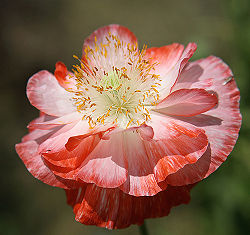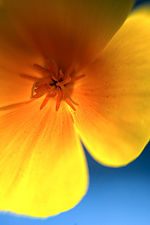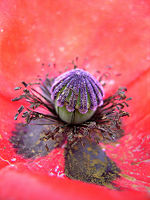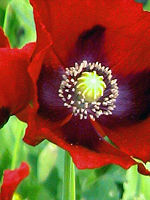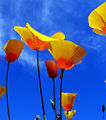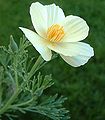Poppy family
| Poppy family |
|---|
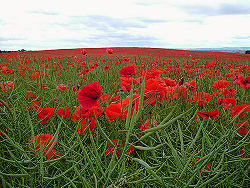
|
| Scientific Classification |
|
| Genera |
|
Poppies are any of a number of showy flowers belonging to the taxonomic family Papaveraceae. Within the poppy family are herbs and shrubs, along with annuals and perennials. Poppy seeds and oil are used in cooking, and their oil is used in paints and varnishes, but the flower is most imfamous are used to make drugs.
Anatomy
There is much diversity among the family of Papaveraceae. The leaves are alternate and the stem lacks stipules. The leaves are pretty and uphold radial symmetry. Typically the flowers in Papaveraceae have between 4 and 12 petals. These petals are called corolla, or also known as a ring that forms around the reproductive organs. In California Poppies there is a pattern of 4 leaves, [1] but in Cream Cup’s there is a pattern of 5 leaves. [2] In the leaves of poppy plants, there are minor leaf veins in which the phloem transfers cells. The leaves will sometimes contain hairs, and on other subtaxa it will be absent. [3] The amount and patterns of these leaves vary immensely among the different groups. In a lot of these plants, the flowers are whorled and in a twisting shape. [4] The Matilija Poppy has prickly stems that can inflict pain upon humans and even animals. [5]
Some of these plants are shrubs and small trees. Some are bisexual while others are hermaphroditic. These quaint flowers are almost entirely odorless. A lot of these plants contain alkaloids which make them poisonous and when consumed by the human body, it can cause edema and glaucoma. [6]. The stem is composed of a ring of bundles or even 2 or more rings of bundles. [7]
Reproduction
The Androecium is a set of stamens in a single flower and it typically consists of numerous stamens; these are the male reproductive organ of a flower and it usually produces pollen. [8] The Gynoecium usually has a compound pistil with 2 to 100 carpels (the female reproductive organ that surrounds the fertilized ovules). [9] These plants are occasionally hermaphroditic. [10] Most of the flowers in this family are pollinated by insects and a few are pollinated by the wind. A flower typically has between 16 and 60 stamens. The ovary claims superiority and is 1-nocular (has one chamber). The endosperm provides nutrients for the flower and is found to be oily. [11] The calyx (the structures that protects the flower buds) consists of 2 or 3 separate, but sometimes conglomerated, sepals (a modified leaf) that are usually unattached as the bud opens. The fruit that these organs produce tend to be capsular and it normally releases its seeds through valves or pores. [12] The California poppy has a slender fruit that sends out its seeds through valves and the fruit splits in half to discharge the many black seeds. [13] The cream cup poppy is not capable of self-fertilization and the bee has proved to be the most efficient source of fertilization. [14]
Ecology
Papaveraceae are usually found in temperate and subtropical regions. [15] These pygmy poppies are herbs that are found annually and encompass a dicot structure. [16] These plants are found literally all over and the Matilija poppy is found in canyons and dry areas as well. This specific plant consists of a woody base with heavy branches and are perennials. [17]
Uses
Poppy is claimed to be one of the most medicinal plants because it is commonly used pharmaceutically and to relieve pain. Papaver bracteatum is morphine free poppy and is the safest one to use for medicinal purposes.
The opium poppy is widely cultivated in Iran, Turkey, Romania, Yugoslavia, Czechozlovakia, Poland, Holland and other coutries as well. The flowers are sometimes found as white, pink, red or purple.
The drug is obtained from a latex that is obtained from immature seed capsules only 1-3 weeks after it flowers. To cultivate, the bud is slit open and the milky substance is then collected and dried out. Many drugs are isolated, but a few of the popular ones are morphine and codeine from which heroine is obtained.
Poppy seeds are used on food as decoration and texture. Poppy oil is sometimes used as cooking oil. Poppy oil is sometimes an ingredient in paints and varnishes.[18]
Gallery
Opium Poppy
(P. somniferum)
Genus: PapaverPrickly Poppy
(A. munita)
Genus: ArgemoneWind Poppy
(S. heterophylla)
Genus: StylomeconCream Cups
(P. californicus)
Genus: PlatystemonCalifornia poppy
(E. californica)
Genus: EschscholziaMexican Gold Poppy
(E. mexicana)
Genus: Eschscholtzia
References
- Classification. Natural Resources Conservation Service
- FAMILY_Papaveraceae, Papaver somniferum L.
- Papaveraceae
- Papaveraceae
- Papaveraceae Juss. The Families of Flowering Plants
- California poppy
- Pygmy Poppy GardenGuides.com
- California Wildflowers Cream Cups Platystemon californicus (Papaveraceae)
- Matilija Poppy Romneya coulteri
